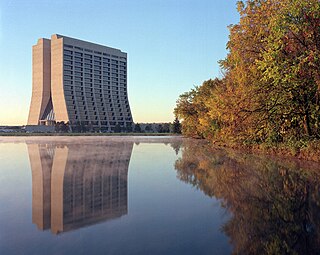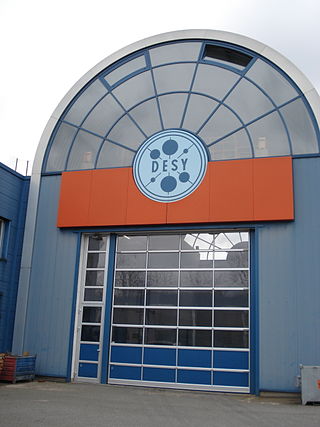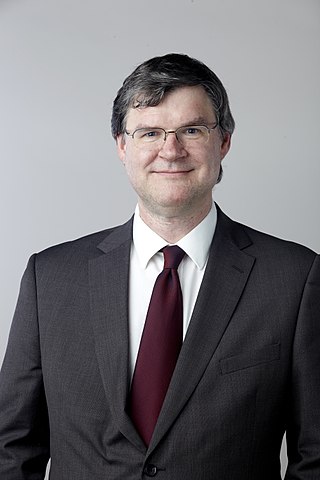
Particle physics or high-energy physics is the study of fundamental particles and forces that constitute matter and radiation. The field also studies combinations of elementary particles up to the scale of protons and neutrons, while the study of combination of protons and neutrons is called nuclear physics.

In particle physics, the W and Z bosons are vector bosons that are together known as the weak bosons or more generally as the intermediate vector bosons. These elementary particles mediate the weak interaction; the respective symbols are
W+
,
W−
, and
Z0
. The
W±
bosons have either a positive or negative electric charge of 1 elementary charge and are each other's antiparticles. The
Z0
boson is electrically neutral and is its own antiparticle. The three particles each have a spin of 1. The
W±
bosons have a magnetic moment, but the
Z0
has none. All three of these particles are very short-lived, with a half-life of about 3×10−25 s. Their experimental discovery was pivotal in establishing what is now called the Standard Model of particle physics.

ATLAS is the largest general-purpose particle detector experiment at the Large Hadron Collider (LHC), a particle accelerator at CERN in Switzerland. The experiment is designed to take advantage of the unprecedented energy available at the LHC and observe phenomena that involve highly massive particles which were not observable using earlier lower-energy accelerators. ATLAS was one of the two LHC experiments involved in the discovery of the Higgs boson in July 2012. It was also designed to search for evidence of theories of particle physics beyond the Standard Model.

The Large Electron–Positron Collider (LEP) was one of the largest particle accelerators ever constructed. It was built at CERN, a multi-national centre for research in nuclear and particle physics near Geneva, Switzerland.

The Underground Area 2 (UA2) experiment was a high-energy physics experiment at the Proton-Antiproton Collider — a modification of the Super Proton Synchrotron (SPS) — at CERN. The experiment ran from 1981 until 1990, and its main objective was to discover the W and Z bosons. UA2, together with the UA1 experiment, succeeded in discovering these particles in 1983, leading to the 1984 Nobel Prize in Physics being awarded to Carlo Rubbia and Simon van der Meer. The UA2 experiment also observed the first evidence for jet production in hadron collisions in 1981, and was involved in the searches of the top quark and of supersymmetric particles. Pierre Darriulat was the spokesperson of UA2 from 1981 to 1986, followed by Luigi Di Lella from 1986 to 1990.

HERA was a particle accelerator at DESY in Hamburg. It was operated from 1992 to 30 June 2007. At HERA, electrons or positrons were brought to collision with protons at a center-of-mass energy of 320 GeV. HERA was used mainly to study the structure of protons and the properties of quarks, laying the foundation for much of the science done at the Large Hadron Collider (LHC) at the CERN particle physics laboratory today. HERA is the only lepton–proton collider in the world to date and was on the energy frontier in certain regions of the kinematic range.

The LHCb experiment is a particle physics detector experiment collecting data at the Large Hadron Collider at CERN. LHCb is a specialized b-physics experiment, designed primarily to measure the parameters of CP violation in the interactions of b-hadrons. Such studies can help to explain the matter-antimatter asymmetry of the Universe. The detector is also able to perform measurements of production cross sections, exotic hadron spectroscopy, charm physics and electroweak physics in the forward region. The LHCb collaborators, who built, operate and analyse data from the experiment, are composed of approximately 1650 people from 98 scientific institutes, representing 22 countries. Vincenzo Vagnoni succeeded on July 1, 2023 as spokesperson for the collaboration from Chris Parkes. The experiment is located at point 8 on the LHC tunnel close to Ferney-Voltaire, France just over the border from Geneva. The (small) MoEDAL experiment shares the same cavern.

The Collider Detector at Fermilab (CDF) experimental collaboration studies high energy particle collisions from the Tevatron, the world's former highest-energy particle accelerator. The goal is to discover the identity and properties of the particles that make up the universe and to understand the forces and interactions between those particles.

ALICE is one of nine detector experiments at the Large Hadron Collider at CERN. The experiment is designed to study the conditions that are thought to have existed immediately after the Big Bang by measuring the properties of quark-gluon plasma.

The DØ experiment was a worldwide collaboration of scientists conducting research on the fundamental nature of matter. DØ was one of two major experiments located at the Tevatron Collider at Fermilab in Batavia, Illinois. The Tevatron was the world's highest-energy accelerator from 1983 until 2009, when its energy was surpassed by the Large Hadron Collider. The DØ experiment stopped taking data in 2011, when the Tevatron shut down, but data analysis is still ongoing. The DØ detector is preserved in Fermilab's DØ Assembly Building as part of a historical exhibit for public tours.
Leptoquarks are hypothetical particles that would interact with quarks and leptons. Leptoquarks are color-triplet bosons that carry both lepton and baryon numbers. Their other quantum numbers, like spin, (fractional) electric charge and weak isospin vary among models. Leptoquarks are encountered in various extensions of the Standard Model, such as technicolor theories, theories of quark–lepton unification (e.g., Pati–Salam model), or GUTs based on SU(5), SO(10), E6, etc. Leptoquarks are currently searched for in experiments ATLAS and CMS at the Large Hadron Collider in CERN.

ZEUS was a particle detector at the HERA particle accelerator at the German national laboratory DESY in Hamburg. It began taking data in 1992 and was operated until HERA was decommissioned in June 2007. The scientific collaboration behind ZEUS consisted of about 400 physicists and technicians from 56 institutes in 17 countries.
The High Luminosity Large Hadron Collider is an upgrade to the Large Hadron Collider, operated by the European Organization for Nuclear Research (CERN), located at the French-Swiss border near Geneva. From 2011 to 2020, the project was led by Lucio Rossi. In 2020, the lead role was taken up by Oliver Brüning.
HERMES was a particle detector at the HERA particle accelerator located at the German national laboratory DESY in Hamburg. The experiment's goal was to investigate the quark–gluon structure of matter by examining how a nucleon's constituents affect its spin. It later developed into a pioneering experiment for measuring generalised parton parton distributions and a general-purpose experiment for the study of QCD processes. HERMES completed its first run between 1995 and 2000, and its second run between 2001 and 2007. It measured 3.5 m × 8 m × 5 m and weighed 400 tons.

David George Charlton is Professor of Particle Physics in the School of Physics and Astronomy at the University of Birmingham, UK. From 2013 to 2017, he served as Spokesperson of the ATLAS experiment at the Large Hadron Collider at CERN. Prior to becoming Spokesperson, he was Deputy Spokesperson for four years, and before that Physics Coordinator of ATLAS in the run-up to the start of collision data-taking.

The Future Circular Collider (FCC) is a proposed particle accelerator with an energy significantly above that of previous circular colliders, such as the Super Proton Synchrotron, the Tevatron, and the Large Hadron Collider (LHC). The FCC project is considering three scenarios for collision types: FCC-hh, for hadron-hadron collisions, including proton-proton and heavy ion collisions, FCC-ee, for electron-positron collisions, and FCC-eh, for electron-hadron collisions.
Robin Marshall is an Emeritus professor of Physics & Biology in the School of Physics and Astronomy at the University of Manchester.

FASER is one of the nine particle physics experiments in 2022 at the Large Hadron Collider at CERN. It is designed to both search for new light and weakly coupled elementary particles, and to detect and study the interactions of high-energy collider neutrinos. In 2023, FASER and SND@LHC reported the first observation of collider neutrinos.

Bradley Cox is an American physicist, academic and researcher. He is a Professor of Physics and the founder of the High Energy Physics Group at the University of Virginia.
A Totally Hermetic Electron-Nucleus Apparatus (ATHENA) is a proposed experiment at the future Electron Ion Collider (EIC), in Brookhaven National Laboratory, United States.












